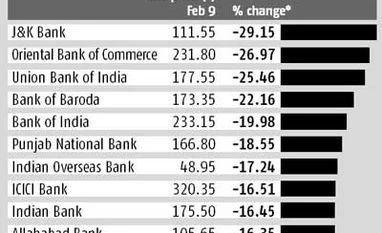The BSE Bankex, an index of 12 leading bank stocks, is down nearly 12 per cent from an all-time high of 23,511.76 on January 27. The index has underperformed the benchmark Sensex, which fell five per cent in this period. State-owned banks, led by Oriental Bank of Commerce, Union Bank and Bank of Baroda, plunged 20 per cent each. Concerns over asset quality, weak credit offtake and lack of capital to fund growth have contributed.
Most public sector banks (PSBs) have announced a sharp drop in profit for the December quarter. This is due to higher provisioning, or setting aside of capital, for bad loans.
“The asset quality in some state-owned banks has been deteriorating quarter-on-quarter, despite reassurances that they'd improve. The results have not been good and it looks like the coming quarters are not going to be any better,” said Daljeet Singh Kohli, head of research, IndiaNivesh Securities.
While the December quarter numbers were expected to be weak, the profit and growth numbers are less than expected. As a result, analysts have become more pessimistic on PSBs. Many fear the asset quality problem might continue to dog the sector for another two or three quarters.
Macquarie Research, in a recent report, said non-performing loans for PSBs would continue to be weak in 2015-16, too. “We would stick to private sector banks and stay away from PSBs. Growth is weak for PSBs, credit costs are going up and they are heavily under-capitalised,” said the brokerage.
Most PSBs are required to raise capital to fund their growth. However, poor valuations are impairing these efforts.
Analysts say playing the banking theme could be challenging for investors this year. Investing in state-owned banks is fraught with risk due to asset quality worries, while valuations of private banks are turning expensive after a sharp rally last year. Most private sector banks' share prices had gained at least 70 per cent in 2014.
Technical analysts say the BSE Bankex is trading below crucial support levels, which could see it fall another three to five per cent.
)